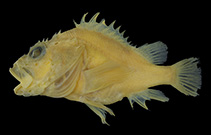Phenacoscorpius mccoskeri Wibowo & Motomura, 2017
McCosker's no-line scorpionfish
Upload your photos and videos
Pictures | Google imagePhenacoscorpius mccoskeri
Picture by Wibowo & Motomura, 2017
Pictures | Google imagePhenacoscorpius mccoskeri
Picture by Wibowo & Motomura, 2017
Classification / Names Common names | Synonyms | Catalog of Fishes(genus, species) | ITIS | CoL | WoRMS | Cloffa
Teleostei (teleosts) > Perciformes/Scorpaenoidei (Scorpionfishes) > Scorpaenidae (Scorpionfishes or rockfishes) > Scorpaeninae
Etymology: Phenacoscorpius: Greek, phenax, -akos = deceptive + Greek, skorpion = scorpion (Ref. 45335); mccoskeri: Named for Dr John E. McCosker, California Academy of Sciences who collected all of the type specimens.
Eponymy: Dr John Edward McCosker (d: 1945) is an ichthyologist and evolutionary biologist who is Senior Scientist and first Professor of Aquatic Research at California Academy of Sciences, San Francisco. [...] (Ref. 128868), visit book page.
Etymology: Phenacoscorpius: Greek, phenax, -akos = deceptive + Greek, skorpion = scorpion (Ref. 45335); mccoskeri: Named for Dr John E. McCosker, California Academy of Sciences who collected all of the type specimens.
Eponymy: Dr John Edward McCosker (d: 1945) is an ichthyologist and evolutionary biologist who is Senior Scientist and first Professor of Aquatic Research at California Academy of Sciences, San Francisco. [...] (Ref. 128868), visit book page.
Environment: milieu / climate zone / depth range / distribution range Ecology
Marine; bathydemersal; depth range ? - 515 m (Ref. 116601). Deep-water
Distribution Countries | FAO areas | Ecosystems | Occurrences | Point map | Introductions | Faunafri
Southeast Pacific: Galápagos Is., off Darwin I.
Size / Weight / Age
Short description Identification keys | Morphology | Morphometrics
Dorsal spines (total): 12; Dorsal soft rays (total): 8 - 9; Anal spines: 3; Anal soft rays: 5. This species is distinguised by the following set of characters: pectoral-fin rays 19-20, with second to ninth rays branched; pored lateral-line scales 5-19 with posteriormost pore situated from below base of fifth dorsal-fin spine to anterior of caudal peduncle; scale rows in longitudinal series 46-48; presence of palatine teeth; small slit behind the fourth gill arch; no second preopercular spine; nuchal and parietal spines are distinct but joined at base; head large, long, its width 17.7-19.5% (mean 18.8%) of SL and length 46.1-51.9% (48.7%) of SL; interorbital space broad, its width at vertical midline of eye 8.0-8.9% (8.3%) of SL and posterior end of preocular spine base 6.2-6.8% (6.4%) of SL; postorbital length 24.1-25.2% (24.7%) of SL; deep caudal peduncle, depth 10.0-11.0% (10.7%) of SL (Ref. 116601).
The specimens were collected from a very steep rocky wall area with white sponges and stony corals, galathiid crabs, large ateleopodids (Guentherus altivela), morids, scorpionfish (Pontius), and catsharks at 515 m depth. It was observed to be solitary and not associated with other animals (Ref. 116601).
Life cycle and mating behavior Maturity | Reproduction | Spawning | Eggs | Fecundity | Larvae
Main reference
Upload your references | References | Coordinator | Collaborators
Wibowo, K. and H. Motomura, 2017. A new species of the deepwater scorpionfish genus Phenacoscorpius (Teleostei: Scorpaenidae) from the Galápagos Islands. Zootaxa 4323(2):261-268. (Ref. 116601)
IUCN Red List Status (Ref. 130435: Version 2024-2)
Data deficient (DD) ; Date assessed: 15 September 2022
CITES
Not Evaluated
Threat to humans
Harmless
Human uses
FAO - Publication: search | FishSource |
More information
Trophic ecology
Food items
Diet composition
Food consumption
Food rations
Predators
Food items
Diet composition
Food consumption
Food rations
Predators
Ecology
Ecology
Ecology
Population dynamics
Growth parameters
Max. ages / sizes
Length-weight rel.
Length-length rel.
Length-frequencies
Mass conversion
Recruitment
Abundance
Growth parameters
Max. ages / sizes
Length-weight rel.
Length-length rel.
Length-frequencies
Mass conversion
Recruitment
Abundance
Life cycle
Reproduction
Maturity
Maturity/Gills rel.
Fecundity
Spawning
Spawning aggregations
Eggs
Egg development
Larvae
Larval dynamics
Reproduction
Maturity
Maturity/Gills rel.
Fecundity
Spawning
Spawning aggregations
Eggs
Egg development
Larvae
Larval dynamics
Anatomy
Gill area
Brain
Otolith
Gill area
Brain
Otolith
Physiology
Body composition
Nutrients
Oxygen consumption
Swimming type
Swimming speed
Visual pigments
Fish sound
Diseases & Parasites
Toxicity (LC50s)
Body composition
Nutrients
Oxygen consumption
Swimming type
Swimming speed
Visual pigments
Fish sound
Diseases & Parasites
Toxicity (LC50s)
Genetics
Genetics
Heterozygosity
Heritability
Genetics
Heterozygosity
Heritability
Human related
Aquaculture systems
Aquaculture profiles
Strains
Ciguatera cases
Stamps, coins, misc.
Aquaculture systems
Aquaculture profiles
Strains
Ciguatera cases
Stamps, coins, misc.
Tools
E-book | Field guide | Length-frequency wizard | Life-history tool | Point map | Classification Tree
| Catch-MSY |
Special reports
Download XML
Internet sources
AFORO (otoliths) | Aquatic Commons | BHL | Cloffa | BOLDSystems | Websites from users | Check FishWatcher | CISTI | Catalog of Fishes: genus, species | DiscoverLife | ECOTOX | FAO - Publication: search | Faunafri | Fishipedia | Fishtrace | GenBank: genome, nucleotide | GloBI | Google Books | Google Scholar | Google | IGFA World Record | MitoFish | Otolith Atlas of Taiwan Fishes | PubMed | Reef Life Survey | Socotra Atlas | Tree of Life | Wikipedia: Go, Search | World Records Freshwater Fishing | Zoobank | Zoological Record
Estimates based on models
Phylogenetic diversity index (Ref. 82804): PD50 = No PD50 data [Uniqueness, from 0.5 = low to 2.0 = high].
Bayesian length-weight: a=0.01778 (0.00689 - 0.04588), b=3.04 (2.82 - 3.26), in cm total length, based on LWR estimates for this (Sub)family-body shape (Ref. 93245).
Trophic level (Ref. 69278): 3.6 ±0.6 se; based on size and trophs of closest relatives
Resilience (Ref. 120179): High, minimum population doubling time less than 15 months (Preliminary K or Fecundity.).
Fishing Vulnerability (Ref. 59153): Low vulnerability (10 of 100).




